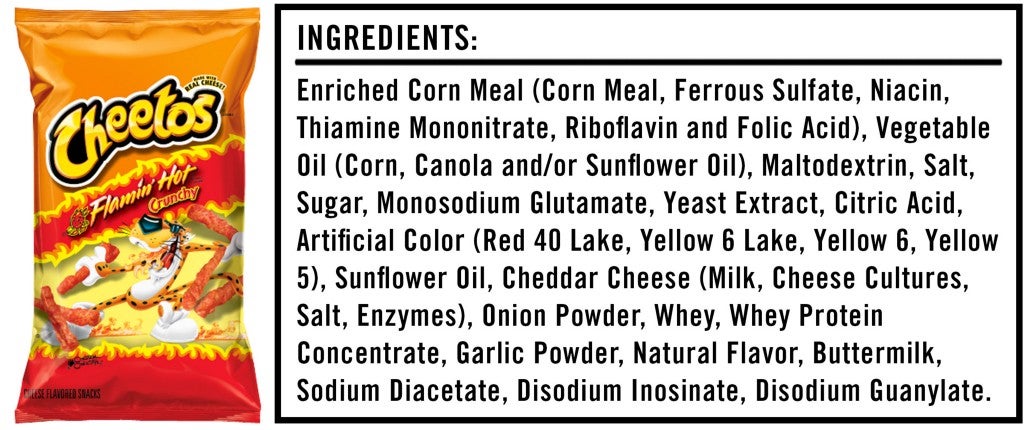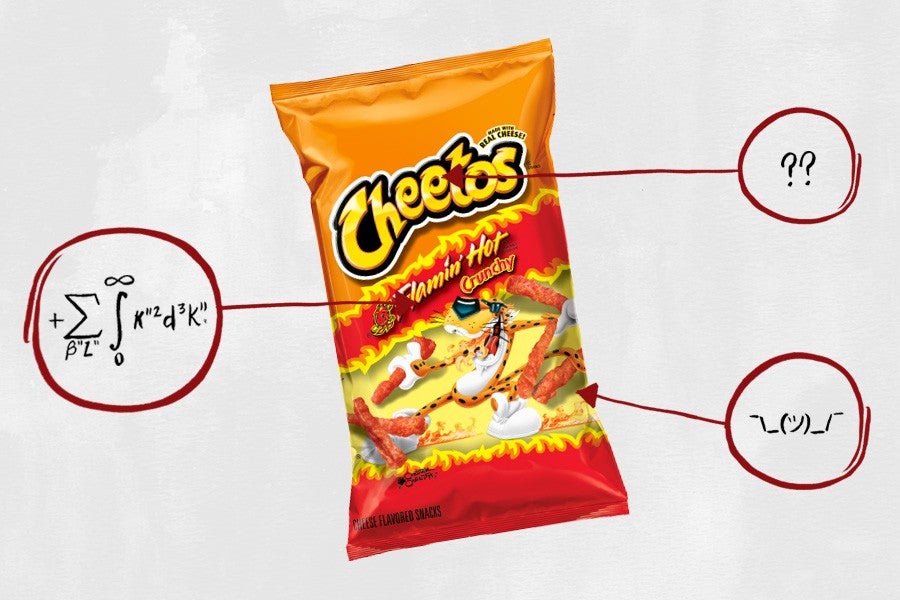We’re often told that you should never eat anything (or put anything on your body) if you don’t recognize everything on the ingredients list. But since most of us have no idea what xanthan gum or potassium benzoate are — or more importantly, what they’re doing to our bodies — we’re decoding the ingredients in the many things Americans put in (and on) themselves with the help of an expert.
This edition: Flamin’ Hot Cheetos, which are made from 21 separate ingredients that we’ve broken down in the exact order they appear on their website.
But before diving into the ingredients, here’s some distressing news: After consuming four bags of spicy snacks like Flamin’ Hot Cheetos and Takis per week, a 17-year-old from Memphis began experiencing stomach pains that resulted in the surgical removal of her gallbladder. While these controversial junk foods aren’t necessarily associated with gallbladder problems, doctors have previously warned that they may cause stomach issues in children.
In response to the recent story, Cary Cavender, a gastroenterologist at Le Bonheur Children’s Hospital, told WREG-TV that spicy eats like these regularly send kids to his hospital. “We do see tons of gastritis and ulcer-related stuff due to it,” Cavender told the station. “We probably see around 100 kids a month, easily.” Meanwhile, Frito-Lay, the maker of Flamin’ Hot Cheetos, told WREG-TV that while food safety comes first for the company, “Some consumers may be more sensitive to spicy foods than others.”
With that, let’s get to it…

The Chips
1) Enriched Corn Meal (Corn Meal, Ferrous Sulfate, Niacin, Thiamine Mononitrate, Riboflavin and Folic Acid): Enriched corn meal undergoes processing to have the kernels removed in order to prevent spoilage (oil in the kernels go bad quickly). To make up for those lost nutrients, it’s then enriched with thiamine (which helps the body turn food into energy), riboflavin (which, similar to thiamine, supports cellular functions that provide you with energy), niacin (which supports the digestive system, skin and nervous system) and iron (aka, ferrous sulfate, which helps deliver oxygen throughout the body).
2) Vegetable Oil (Corn, Canola and/or Sunflower Oil): Physician and biochemist Cate Shanahan, author of Deep Nutrition: Why Your Genes Need Traditional Food, previously told us that consuming too much vegetable oil (sunflower, canola or corn) — which is easy to do, considering she says roughly 45 percent of the average American’s calories come from refined oils — has serious repercussions (i.e., fatty liver disease, insulin resistance and migraines). While it’s nearly impossible to eliminate vegetable oil from your diet altogether — major contributors include processed foods, fried foods, frozen pizzas, cakes, cookies, margarines and coffee creamers — it’s best consumed in moderation.
The Flamin’ Hot Seasoning
3) Maltodextrin: An artificial sugar made from maltose (aka malt sugar) and dextrose (a sugar derived from starches), maltodextrin is usually used as a thickener or filler ingredient to add bulk to processed food and to increase its shelf life. (Maltodextrin itself has a shelf life of two years.)
4) Salt: For flavor.
5) Sugar: For sweetness.
6) Monosodium Glutamate: Best known as MSG, monosodium glutamate is a naturally occurring amino acid (one of the building blocks of protein) that’s added to foods as a savory flavor enhancer. Despite having a bad reputation for causing insatiable hunger, the food industry has no problem using it because it occurs in nature. And while Shanahan sort of agrees, there’s some room for worry. “Eating MSG without a high-protein ingredient in the food is a huge blast of MSG all at once, and some people are very sensitive to that,” she told us during our analysis of Doritos. “They’ll get headaches, and some people who get seizures say they’ll get a seizure aura [that is, the feeling you get right before you experience a seizure].” Researchers, however, haven’t come to any decisive conclusions about the negative effects of MSG.
7) Yeast Extract: Also known as autolyzed yeast, yeast extract results when yeast is broken down into its individual components, which include the flavor enhancer MSG.
8) Citric Acid: Citric acid naturally occurs in citrus fruits; it’s often added to foods to extend their shelf life.
9) Artificial Color (Red 40 Lake, Yellow 6 Lake, Yellow 6, Yellow 5): Artificial colors have a bad reputation, but as Shanahan also explained during our analysis of Doritos, studies arguing this are a bit flawed: “I’ve always been of the opinion that studies claiming artificial colors can cause cancer are irrelevant because [in the studies] they use really high amounts of the artificial colors — like, a million times more than you’d ever get [in your] food [throughout your lifetime].”
All in all, the average person’s liver should be able to break down whatever minuscule amount of artificial coloring we consume with food and drink.
10) Sunflower Oil: See vegetable oil above.
11) Cheddar Cheese (Milk, Cheese Cultures, Salt, Enzymes): As Shanahan also explained to us during our analysis of Doritos, suspicious-sounding ingredients like “cheese cultures” and “enzymes” are nothing to worry about: “Starter cultures and enzymes are used to accelerate the process of coagulating milk into cheese. Pretty much all cheese is made using some kind of enzyme to speed up the fermentation process.”
12) Onion Powder: This is an easy one — dehydrated, ground onion used for flavoring.
13) Whey: Whey is essentially the liquid leftovers after milk has been curdled and strained. It’s usually added to processed foods as a source of protein and to add bulk.
14) Whey Protein Concentrate: As Dagan Xavier, ingredient expert and co-founder of Label Insight, explained to us during our investigation of protein powder, this is a form of whey protein (the protein-packed leftovers of cheese production) that contains a significant amount of whole nutrients.
15) Garlic Powder: Yep, you guessed it, just dehydrated, ground garlic.
16) Natural Flavor: Natural flavors are quite literally flavors derived from an actual food source — i.e., cheese flavoring taken from real cheese.
17) Buttermilk: Similar to whey, buttermilk is the byproduct of churning butter out of cream and is usually added to processed foods like Flamin’ Hot Cheetos as a means of adding heartiness and oftentimes a sort of creamy texture (though, that’s not so much the case for these Cheetos).
18) Sodium Diacetate: Sodium diacetate is an acidic sodium salt widely used as a preservative to control the growth of mold and bacteria in food. It’s also commonly added to meat and poultry as a pH regulator.
19) Disodium Inosinate: A savory flavor enhancer that’s almost always used in conjunction with MSG and disodium guanylate. It’s a purine, meaning it’s one of the building blocks of DNA, and thus, it’s often derived from animal origin like beef, pork, poultry and fish. So if you’re a vegetarian or a vegan, be sure to avoid products containing disodium inosinate.
20) Disodium Guanylate: Used in conjunction with MSG and disodium inosinate (see below), disodium guanylate has a savory taste that essentially allows manufacturers to increase the flavor of food without loading it with sodium. The risk of consuming too much of this stuff is more or less the same as MSG — i.e., headaches and nausea. Again, though, Shanahan previously told us there’s no reason to worry about these flavor enhancers as long as you consume them alongside some kind of protein — like, say, a slab of turkey — to quell the negative effects.
The (Additional) Salt
21) Salt: For more flavor.
The Takeaway
While MSG is certainly worth avoiding if possible, the most problematic ingredient in Flamin’ Hot Cheetos is vegetable oil. “The main thing people need to pay attention to are the first few ingredients in these foods, like vegetable oil,” Shanahan urges. “Vegetable oils alone can cause diabetes, and they don’t even contain any sugar.”
*attempts to sneakily lick bright red Cheeto dust off fingers, keyboard, desk, shirt and pants*

